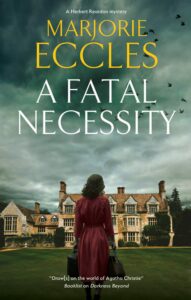Herbert Reardon #6
 This is the first book I’ve read in this series, but it won’t be the last. This novel is set in 1935, on the cusp of war. The first book took place in 1919, just after WWI, as Britain attempted to put itself back together. In this novel, while life is fairly peaceful in the village of Templewood in Worcestershire, it’s not so peaceful for one particular family. As the book opens, the wife of a prominent judge has left her husband a note that she’s leaving him. When they find her, her body is in the skeleton of a house site where she had planned to build a new home, and her suitcases are sitting right next to her. It’s pretty apparent she’s been murdered.
This is the first book I’ve read in this series, but it won’t be the last. This novel is set in 1935, on the cusp of war. The first book took place in 1919, just after WWI, as Britain attempted to put itself back together. In this novel, while life is fairly peaceful in the village of Templewood in Worcestershire, it’s not so peaceful for one particular family. As the book opens, the wife of a prominent judge has left her husband a note that she’s leaving him. When they find her, her body is in the skeleton of a house site where she had planned to build a new home, and her suitcases are sitting right next to her. It’s pretty apparent she’s been murdered.
The town is tiny and DCI Reardon and Sergeant Jago, a man new to him, are assigned to the case. Jago has been working in London where things are heating up thanks to Oswald Mosley’s gang of thugs. The two end up working well together as they begin to quiz the family of the dead woman, Emilie. Her husband, his two daughters, and his stepson and tutor are all part of the mix, as is a neighboring family whose daughter is a contemporary of the judge’s Sophy and Gizi.
This entire story is subtly and carefully told. As revelations emerge about Emilie’s past and how that past might tie to her death, each suspect, from the gardener to the housekeeper to the daughters and the men hanging around Gizi and the neighboring family’s daughter, Dee, are delicately and memorably portrayed. Dee is engaged to one of them and all of the young men seem fast and somewhat louche. Gizi even seems to feel some affinity for the black shirted Mosleyites, alarming her father.
Reardon and Jago are both good characters – Reardon older and more settled in life, Jago just getting started, and they work well together. The whole relationship between the two men and really, between all the characters in the book, feels very organic, as does the storytelling. Each bit of a clue and revelation of character builds on the one before it, growing into a coherent picture.
It’s gently told, and that’s a term I sometimes use when I mean a book is slow or dull, but that was not the case here. Eccles may simply be the least show-offy of writers. Subtlety is her storytelling method, and with her light touch, it’s an excellent method. There were quite a few characters and a complex backstory for the dead woman, but both characters and their relationship to one another stayed clear in my mind.
Overlaying the novel is the threat of the Moseleyites as well as that of Hitler, and Sophy and Gizi’s brother Sam, who has left a banking job in Berlin, and has his own horror story to tell. Subtle storytelling can be just as chilling, resonant and effective as a more in your face method. It’s the build up that gets you. Another author who employs this method is Ann Cleeves, whose books are a slow burn, and this trip backward to 1935 is also a slow burn. I loved the writing and the characters, and if you’re looking for an historical novel that seems like it was actually written in 1935, look no further. — Robin Agnew